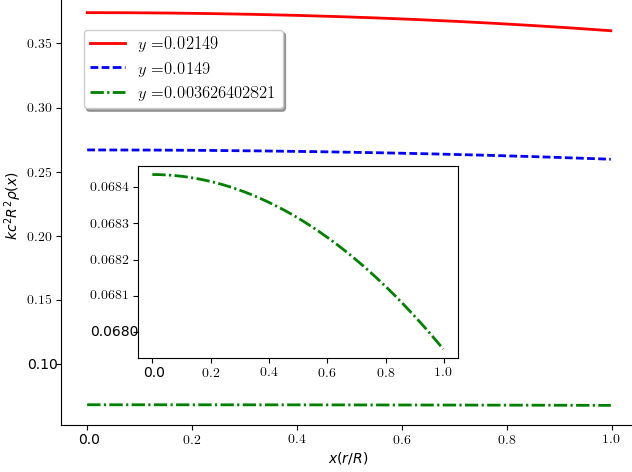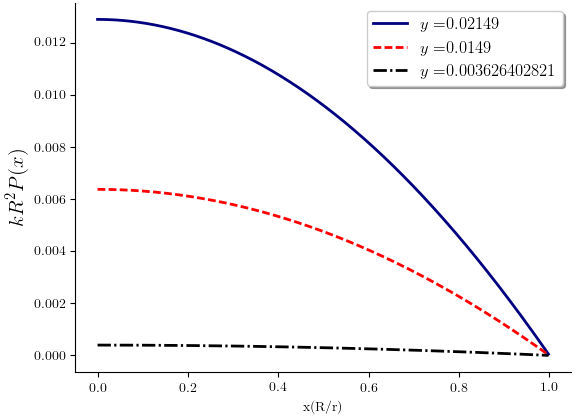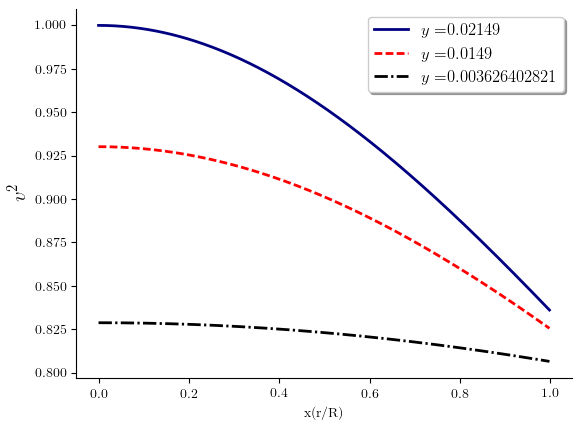1. Introduction
The behavior of particles inside compact stars like white dwarfs, formed by matter with density lower than the nuclear density, can be experimentally reproduced in some cases by means of nuclear accelerators [1,2]. In adittion, complementary theoretical models that help describing the interactions in the interior of compact stars, even for low energy interactions, the dynamics can be explored as well through general relativity or non relativistic effective theories [3,4]. For compact objects like neutron or quark stars that have a density larger than the nuclear density it is necessary to consider theoretical models using gravitational theories like general relativity. On the other hand, even though experiments have been carried out to explore the quark reactions that could happen inside the stars, the development of experiments for these order of densities is not possible at laboratory level yet. However, phenomenological models approaching compact stars through equations of state with parameters determined by comparison with observations have been proposed [5,6].
Among the different kinds of stars are the low mass ones, whose behavior can be different from those with mass on the order of the sun mass. On this subject, there is still no consensus about the equations of state that could describe the interior of these stars, although different models are being currently used, from those that assume polytropic equations [7] to others like PARSEC models [8]. While the description of the interior of static stars is carried out through the construction of solutions to the Einstein equations, some of which assume that the interior is described by a perfect fluid [9-11], anisotropic [12,13], and charged [14-17], these last two models are characterized by compactness values that are larger than the ones in the case described by a perfect fluid [18,19].
Some other ways to build interior solutions is by means of imposing some geometric condition, one of which is to suppose four-dimensional space-time embedded in a five-dimensional pseudo Euclidean space [20,21] known as Class I solutions for a spherically symmetric space-time there is a differential equation that relates the metric functions grr and gtt that, under suitable choices of one of these functions allows integrating the system, generating physically acceptable models [22].
The type of solutions Class I is useful when stellar models without charge and anisotropic pressures are proposed [21-24] or with anisotropic pressures and electrically charged [25], and has been used to describe the interior of compact objects such as Cen X-3, PSR J0348+0432, PSR B0943+10 and XTE J1739-285. However for the case of stellar models associated with perfect fluid, the condition that the radial pressure Pr and tangential pressure Pt be the same, implies a differential equation between the metric potentials grr and gtt, different from solutions of the Class I. and in such case a there is no guarantee that these functions satisfy both equations.
In our case we propose a model described by a perfect fluid. Therefore, the construction of our solution, obtained from the differential equation emerging from the equality of radial and tangential pressures Pt = Pr and from imposing a new gravitational potential gtt motivated by recent work [26,27] in which new physically acceptable stellar solutions have been built with a different form to those previously proposed [28]. An advantage of the choice of our potential gtt is that it generates a model with a speed of sound that is monotonically decreasing as a function of the radial coordinate. We also show that the model is physically acceptable and that it can be applicable to the star PSR B0943 + 10.
Physically acceptable solutions for a perfect fluid in a spherically symmetric space are required to satisfy the following conditions [28]:
The solution must be regular, i.e. the geometry and the physical quantities inside the star have to be non-singular.
The pressure is null on the star surface.
The pressure and density must be positive and monotonic decreasing functions of r.
The causality condition must be satisfied, the sound speed must be lower than the speed of light.
The gravitational redshift function must be positive, finite and monotonically decreasing in r.
Among the set of stars of low mass there are some compact stars, like the PSR B0943 + 10 with mass 0.02 Mʘ and radius 2.6 km, a quark star candidate [29] with compactness ratio equal to 0.06093. In this work, we intend to describe this object using the low mass star model that is introduced in what follows.
This paper is organized in the following manner: In Sec. 2 we work out the solution considering that the interior of the star is described by a perfect fluid; Section 3 focuses on obtaining the validity intervals for the parameters involved in the model, stemming from the physical conditions mentioned above. In Sec. 4 we show that this solution applies to low mass compact stars and that it describes the behavior of PSR B0943 + 10. Finally, we end with the conclusions of this analysis.
2. Perfect fluid solution
According to the Jebsen-Birkhoff theorem for stellar models, the exterior of a star is described by the Schwarzschild metric [30-32]
where M is the mass of the star, G is the gravitational constant and c is the speed of light. This metric and its second fundamental form have to be continuous over the boundary [33,34]. On the other hand, the interior geometry r ≤ R, for a perfect fluid, is determined by the solution of the Einstein equations
where Gμv are the Einstein tensor components, P is the pressure, ρ is the density of the energy-matter measured by an observer with a four-velocity uμ and gμv the metric components, which for a static and spherically symmetric spacetime can be described by the line element
Considering this metric in Eq. (2), one obtains the conditions
And from the Bianchi identity ∇μ Gμv = 0, Eq. (2) implies
where ' denotes the derivative with respect to the r coordinate. Substituting the form of the density and the pressure given by Eqs. (4) and (5) in Eq. (6), it follows that Eq. (6) is satisfied, so we only need to consider the system formed by Eqs. (4)-(6). To build a model that is applicable to a compact low mass star, we assume a particular form of Y(r)given by
Although this function is new, the functional form of this has recently been proposed [26,27] to generate stellar models that describe compact objects. Therefore, guided by the previous results, we assume this functional form. If we use this in the expressions for the pressure given by Eqs. (5) and (6) and subtracting one from the other, the following differential equation for B results
This can be solved analytically and allows us to obtain
with
The functions Y and B, given by Eqs. (8) and (10) respectively, determine the metric and allow us to get the form of the hydrostatical variables. From B and Eq. (4), the density follows
where S1 (r) is given by:
The pressure is obtained from Eq. (5) using Y and the function B
Another relevant parameter in the construction of a stellar model is the speed of sound defined as:
from where we get:
with:
Having solved the system of equations for the perfect fluid model, we now proceed to determine the validity intervals of the parameters in order to have a physically acceptable solution.
3. Behavior of the solution
The determination of the physical values of the model parameters requires to fulfil the conditions listed in Sec 1. The first derivative of the pressure, density and speed of sound at the origin vanish. On the other hand, evaluation of the functions and their second derivatives at the origin, results in the following set of inequalities after imposing the conditions enunciated in Sec. 1
The sign of a is determined by
Hence a < 0and using the previous set of inequalities, we find that these are satisfied if
The integration constant A is related to a and the radius of the object, R, since the pressure must be null on the surface, that is P(R) = 0. Imposing this condition we get with y = aR2 > 0. From here we see that the model depends only on the parameter y. Using this form of A in Eq. (15) and the fact that A(y) is a monotonic decreasing function for y > 0 in the range given by the inequality (15), the maximum acceptable value for y = ymax takes place when A(ymax) = (387/256), from where we get y ∈ [0,0.2149]. In this y interval, the forms of the density, pressure and speed of sound functions inside the star are described by the Figs. 1-3. For the graphic representation of these functions we define dimensionless variables r → x = r/R, ρ → kR2c2ρ, P → kR2 P and v2 → v2/c2.
Figure 1 shows that the density is a monotonic decreasing function and that the difference between the density in the core and on the surface lowers as the value of y decreases. The maximal difference between the density in the surface and in the core happens for y = 0.02149, when we have ρc = 1.0394ρb.
The behavior observed in Fig. 2 for the pressure is the expected one for physically acceptable solutions in the case of a perfect fluid, that is, a monotonic decreasing behavior and the existence of a region, the surface, where the pressure is null.
As we can see from Fig. 3, the speed of sound at the core for the maximal value of y is the same as the speed of light in vacuum and decreases as the distance to the surface decreases. Moreover, when y has lower values, the speed of sound in the interior decreases. From the figures presented here, we have that the behavior of the density, pressure and speed of sound correspond to monotonic positive decreasing regular functions, which makes this model physically acceptable.
4. Compact stars of low mass
From the condition of continuity between the internal and the external metrics, we obtain the constant C2 = (1-2GM / c2R) / Y(R) and the compactness ratio
which together with the form of the density profile determine the kind of objects that can be described by the model. In this case, the value of the compactness u = u(y) as a function of y is monotonic and decreasing, so its minimal value is obtained for y = 0 and its maximal value takes place for y = 0.02149, being u = 0.06093. For this value of maximal compactness, the speed of sound at the origin is the same as the speed of the light and the value on the surface is 0.91404c, while the maximal value of the density ratio core/surface is ρc / ρb = 1.0394. This allows us to propose that the model presented in this analysis is applicable to compact low-mass stars. One of these stars is the quark star candidate PSR B0943 + 10, with observed mass 0.02 Mʘ and radius R = 2.6 km.
If we consider the maximum compactness value, there is still room for a variety of different stars. For instance, if the mass is M = 0.02 Mʘ, its radius will be R = 4.8464 km, with central density ρc = 8.5338x1017 kg/m3 and surface density ρb = 8.2107x1017 kg/m3. While for a star with radius 2.6 km, the mass would be M = 0.1073 Mʘ, with central density ρc = 2.9651x1018 kg/m3 and surface density ρc = 2.8529x1018 kg/m3. In these two cases, the object with higher density, approximately ten times the nuclear density, is the one with lower mass and radius.
For the case of PSR B0943 + 10, with compactness u = 0.01136, our analysis delivers the values for the parameter space in the interior of the star kisted in Table I.
Table I Behavior inside of a star with compactness ratio u = 0:01136.
| r(m) | ρ(1017 kg/m3) | P(1032 Pa) | vs(c) |
| 0 | 5.4266 | 2.8301 | 0.9103 |
| 260 | 5.4262 | 2.8016 | 0.9102 |
| 520 | 5.4251 | 2.7163 | 0.9098 |
| 780 | 5.4232 | 2.5740 | 0.9092 |
| 1040 | 5.4205 | 2.3751 | 0.9083 |
| 1300 | 5.4170 | 2.1195 | 0.9072 |
| 1560 | 5.4128 | 1.8075 | 0.9058 |
| 1820 | 5.4078 | 1.4393 | 0.9042 |
| 2080 | 5.4020 | 1.0151 | 0.9023 |
| 2340 | 5.3954 | 0.5352 | 0.9003 |
| 2600 | 5.3881 | 0 | 0.8979 |
Hence, even though the density is a monotonic decreasing function, its variation is very slow since both the central density and the density at the surface are of the same order ρc = 1.0072ρb , and higher than the nuclear density, which is characteristic of the quark stars. A similar pattern is followed by the speed of sound, that satisfies vs (0) = 1.0138vs (R). The evolution of these two parameters can be seen in Figs. 1 and 3 and correspond to the curves at the bottom of each panel, with y = 0.0036. From here we see that the model is adequate and physically acceptable to represent the star PSR B0943 + 10.
5. Conclusions
Assuming a specific form for the metric function Y(r), we derive a relativistic stellar solution for compact stars considering a perfect fluid to model its interior. The regular and monotonic decreasing evolution of the density, pressure and speed of sound makes the solution physically acceptable. On the other hand, we show that the speed of sound grows with density and equals the speed of light in the center of the star for the highest density case. When we apply this model to the quark star candidate PSR B0943 + 10, with mass 0.02 Mʘ and radius R = 2.6 km, it comes out that the density at the surface is ρb = 5.3881x1017 kg/m3, which is larger than the nuclear saturation density, and its central density is slightly higher than the surface density ρc = 1.0072ρb , which is a characteristic density for compact stars. Although we have chosen the star PSR B0943 + 10 to apply our model, it can be useful as well to analyse stars with compactness ratio u ≤ 0.06093.











 nueva página del texto (beta)
nueva página del texto (beta)





